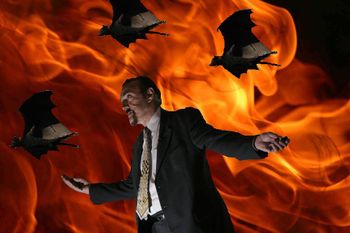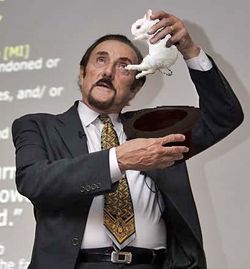Philip Zimbardo
“Kneel before Zimbardo!”
“He's one bad mother-”
– Isaac Hayes on Philip Zimbardo
“Shut your mouth!”
– Aunt Rachel from Family Matters
“This guy borrowed $50 from me last year and disappeared without paying me back! I knew I'd find him somewhere! I'M COMING TO GET YOU!”
– Jesus, perimortem, on Philip Zimbardo
Professor Dr. Philip George Zimbardo (born March 23, 1933), commonly known as Zimbardo the Magnificent or The Master, is an American psychologist and a professor emeritus at Stanford University. He is president of the Heroic Imagination Project. He is known for his Stanford prison study and authorship of various introductory psychology books and textbooks for college students, including The Lucifer Effect and The Time Paradox.
Early life[edit | edit source]
Philip Zimbardo, born Beelzebub Garcia, is the bastard son of the Biblical figure Cain and his demon snake wife, Angelina Jolie. When Zimbardo was 20 months old, he accidentally stumbled out of the gates of Hell and came up through one of the toilets in Yankee Stadium. Using ground up urinal cakes, Zimbardo was able to mask his demonic red skin. As for his horns, he donned a Yankee’s hat, a technique later used by George Steinbrenner. Zimbardo walked out of Yankee Stadium onto the streets of New York, where he quickly made a name for himself as a street performer. One day, as he was in the middle of sawing a hobo in half (to this day known as “Stumpy”), Lydia and Jebediah Zimbardo, an Amish couple living in a Manhattan penthouse, openly expressed their distaste for him right to his face. Using his satanic powers of mind-control, he convinced the simple Zimbardo couple to adopt him. 3 hours later, Jebediah met an unfortunate end when the brakes of his horse and buggy failed and he careened off the road into a ditch. The horse and carriage proceeded to burst into flames, destroying any evidence that the brakes were tampered with. Shortly after, Lydia suffered a terrible accident, the details of which are too gruesome to tell; it involved a grain thrasher, an incandescent light bulb, and an oversized pink paperclip (you can probably imagine what happened). Mysteriously, the Zimbardos had changed their will, which they previously did not have, leaving all of their material possessions, assets, and domesticated livestock to the young boy whom they christened “Philip,” meaning “Lover of horses” (no, really, look it up).
Rise to Power[edit | edit source]
Due to his inheritance, which included a monopoly on all-black belt buckle hats, Philip quickly made his first Amish million, which totaled roughly $62.74 in US currency. To increase his vast fortune, he decided to become a magician. Following in the footsteps of Harry Houdini, Mentok the Mind-Taker, and Bob Dole, Philip took a moniker for his new life on the stage: Zimbardo the Magnificent (shortened from Zimbardo the Magnificent All-Powerful Destroyer of Worlds and Coffee Mugs). At age 4 years and 2 months, Zimbardo was the most well-known magician and illusionist in the known world, the unknown world, and Mars. Quickly bored from being a simple magician, and due to the overwhelming amount of science proving magic to be a lie, Philip decided that he needed a new outlet for his mind-controlling powers. Wanting to work from the inside out to dismantle all science related topics, Zimbardo created his own branch of science. He gathered a large following of followers, forming the cult, “Zimbardo’s Kids.” Once his cult was large enough, he made all of his disciples drink cappuccinos with trace amounts of his sweat in it. They were all instantly and grotesquely transformed into the most horrible creatures the human mind could conceive. Zimbardo called these abominations “psychologists.”
They were perfect. Able to both analyze and control the minds of the people who talked to them, while attaining mass amounts of money to sustain Zimbardo’s empire, psychologists used their intense bullshitting skills to keep the patients coming back for more, slowly corrupting them for Zimbardo’s use. Psychologists quickly spread across America like a particularly bad rash that spreads far and quickly. Especially to the genitals.
Zimbardo Creates the Branches of Psychology[edit | edit source]
Zimbardo created a diverse army of psychologists in order to understand and control every facet of existence. He made five major factions:
- Cognitive psychologists rigorously study the workings of the mind in order to learn how it can best be manipulated and controlled. According to recent studies, jamming a spork into the left frontal cortex just behind the eye can render the victim very, very funny. True cognitive psychologists have strong telekinetic powers, second only to those of Philip Zimbardo.
- Behavioral psychology evolved out of torture. The oldest recorded behavioral experiments took place when Ivan Pavlov, a Russian physiologist, was training his dogs to obey his commands using an electric dog collar. Zimbardo, sensing a new power in the force, quickly made his way to Russia and immobilized Pavlov by strapping the dog collar to Pavlov himself. Pavlov learned how to fetch, sit, and shake hands, but could never quite handle bringing Zimbardo his slippers in the morning.
- Biological psychologists are only interested in how organisms, large bags of chemicals, work. Zimbardo, a hater of all science related topics, uses biological psychologists as spies in the larger scientific community, wreaking havoc wherever they try to put their two cents in.
- Psychoanalytic psychologists are glorified fortunetellers. They believe that dreams can predict a person’s future and can divulge the personality of the person. Being the most perverted group of psychologists, every aspect of a dream is sex: trees, houses, vaginas, large rubber hoses, and certain pieces of classical music. Zimbardo once tried strapping a large group of psychoanalysts together to use their fortune-telling powers to tell him the winning lottery numbers on March 24th, 2087; the central psychoanalyst was none other than Sigmund Freud, the most famous psychoanalyst and porn director. Their results have yet to be validated.
- Humanist psychologists think humans are the shit. Zimbardo created this kind of psychologist so that the human race would think that it is at the top of the pecking order on Earth and, therefore, not rise up in mutiny against the real lord and master of Earth: Philip Zimbardo.
Stanford Prison Study[edit | edit source]
A hotbed of impressionable minds were found at universities strewn across America, other less significant countries, and Mars. Lording above all of the universities, Zimbardo took his throne at ITT Technical Institute. He later escaped to the lesser-known university, Stanford, where he conducted his most famous and twisted psychological experiment ever.
Zimbardo planned to create mass chaos within Stanford by assigning roles to individual students, half being prison guards and half being inmates. The experiment started off innocently enough. There were only 68 instances of rape, 35 shankings (although 13 of them were done to one person, and 12 were done by Zimbardo himself), 109 kilos of cocaine ingested per person, 48 drug overdoses, 13 games of hopscotch deteriorating into sectarian violence, and 96 cases of internal hemorrhaging. The prisoners were rowdy as well. As time went on, the experiment took a sour turn, and Zimbardo didn’t care; he was high out of his mind, drunk on his power and the scotch that was being delivered daily (alcoholism was rampant). However, Zimbardo was forced to shut down the experiment 16 minutes after it began, fearing that the evilness of the participants would surpass his own wickedness, and that he would have to give up his title of, “Most Likely to be a Bond Villain in Another Life,” his prestigious high school superlative.
The Stanford Prison Study was a crucial factor when determining the structure of public education in America and other lesser countries, but not Mars.
Famous Publications[edit | edit source]
• Influencing attitude and changing behavior: A basic introduction to relevant methodology, theory, and applications (Topics in social psychology), Addison Wesley, 1969
Zimbardo’s personal guide to manipulating and coercing the ignorant masses.
• Stanford prison experiment: The Golden Years, Philip G. Zimbardo, Inc., 1972
• The psychology of imprisonment: privation, power, pathology, possessiveness, paternity, platonic relationships, and party planning! Stanford University, 1972
• Canvassing for Peace: A Manual for Volunteers. Ann Arbor, MI: Society for the Psychological Study of Social Issues, 1970, ISBN
Zimbardo explores the joys of physical combat. Rule #1: you do not talk about fight club…
• How to Overcome Shyness. Family Circle magazine, May 31, 1977 page 14 (with questionnaire)
Zimbardo encourages kids to come out of their shells with uplifting real-life stories from motivational speakers, community organizers, actors, and fascist dictators. With a glowing introduction from Adolph Hitler.
• Cults go to high school: the best four years of my life, American Family Foundation, 1985
• Shyness: What It Is, What to Do About It, and Why Mommy’s Drinking is YOUR Fault. Addison Wesley, 1990, ISBN 0-201-55018-0
• The Shy Child : Overcoming and Preventing Shyness from Infancy to Dictatorship, Malor Books, 1999, ISBN 1-883536-21-9
• Violence Workers: Police Torturers and Murderers Reconstruct Brazilian Atrocities. Berkeley, CA: University of California Press, 2002, ISBN 0-520-23447-2
Zimbardo’s accounts of his short-lived employment as a babysitter.

• The Lucifer Effect: Understanding How Good People Turn Evil, Random House, New York, 2007, ISBN 1-400-06411-2
Zimbardo’s accounts of his Stanford Prison experiment. The book was named in honor of Zimbardo's brother and main contributor of human souls, Hades. “Lucifer” was Zimbardo’s childhood nickname for his wacky younger brother.
• The Time Paradox: The New Psychology of Time That Will Change Your Life, Simon & Schuster, New York, 2008, ISBN 1-4165-4198-5
Time travel. Yes, we are scared too.
• The Journey from the Bronx to Stanford to Abu Ghraib to the Starbucks Down the Street. pp. 85-104 in "Journeys in Social Psychology: Looking Back to Inspire the Future", edited by Robert Levine, et al., CRC Press, 2008. ISBN 0805861343

Where Is He Now?[edit | edit source]
No one has seen Philip Zimbardo since the glorious end of the Stanford Prison experiment. However, it is widely believed that he created Japanese foot detox pads. Another conspiracy theory is that one of Zimbardo’s graduate students (the only one who survived, in fact) lured him into marriage and then, with the aid of a Kryptonian wedding ring, trapped him in the Phantom Zone for all of eternity. Maybe.





